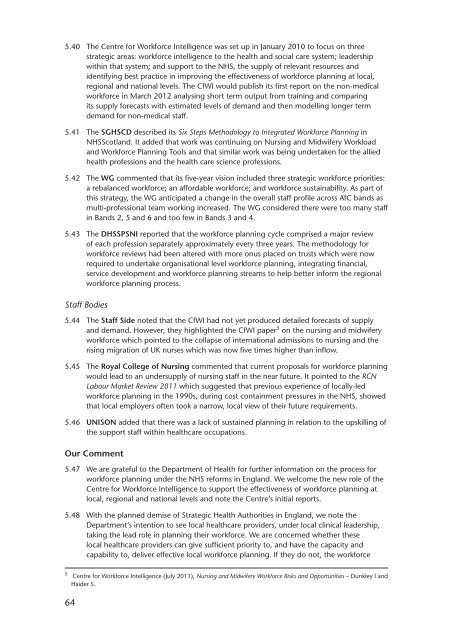NHS pay review body: twenty-sixth report 2012 - Official Documents
NHS pay review body: twenty-sixth report 2012 - Official Documents
NHS pay review body: twenty-sixth report 2012 - Official Documents
You also want an ePaper? Increase the reach of your titles
YUMPU automatically turns print PDFs into web optimized ePapers that Google loves.
5.40 The Centre for Workforce Intelligence was set up in January 2010 to focus on three<br />
strategic areas: workforce intelligence to the health and social care system; leadership<br />
within that system; and support to the <strong>NHS</strong>, the supply of relevant resources and<br />
identifying best practice in improving the effectiveness of workforce planning at local,<br />
regional and national levels. The CfWI would publish its first <strong>report</strong> on the non-medical<br />
workforce in March <strong>2012</strong> analysing short term output from training and comparing<br />
its supply forecasts with estimated levels of demand and then modelling longer term<br />
demand for non-medical staff.<br />
5.41 The SGHSCD described its Six Steps Methodology to Integrated Workforce Planning in<br />
<strong>NHS</strong>Scotland. It added that work was continuing on Nursing and Midwifery Workload<br />
and Workforce Planning Tools and that similar work was being undertaken for the allied<br />
health professions and the health care science professions.<br />
5.42 The WG commented that its five-year vision included three strategic workforce priorities:<br />
a rebalanced workforce; an affordable workforce; and workforce sustainability. As part of<br />
this strategy, the WG anticipated a change in the overall staff profile across AfC bands as<br />
multi-professional team working increased. The WG considered there were too many staff<br />
in Bands 2, 5 and 6 and too few in Bands 3 and 4.<br />
5.43 The DHSSPSNI <strong>report</strong>ed that the workforce planning cycle comprised a major <strong>review</strong><br />
of each profession separately approximately every three years. The methodology for<br />
workforce <strong>review</strong>s had been altered with more onus placed on trusts which were now<br />
required to undertake organisational level workforce planning, integrating financial,<br />
service development and workforce planning streams to help better inform the regional<br />
workforce planning process.<br />
Staff Bodies<br />
5.44 The Staff Side noted that the CfWI had not yet produced detailed forecasts of supply<br />
and demand. However, they highlighted the CfWI paper5 on the nursing and midwifery<br />
workforce which pointed to the collapse of international admissions to nursing and the<br />
rising migration of UK nurses which was now five times higher than inflow.<br />
5.45 The Royal College of Nursing commented that current proposals for workforce planning<br />
would lead to an undersupply of nursing staff in the near future. It pointed to the RCN<br />
Labour Market Review 2011 which suggested that previous experience of locally-led<br />
workforce planning in the 1990s, during cost containment pressures in the <strong>NHS</strong>, showed<br />
that local employers often took a narrow, local view of their future requirements.<br />
5.46 UNISON added that there was a lack of sustained planning in relation to the upskilling of<br />
the support staff within healthcare occupations.<br />
Our Comment<br />
5.47 We are grateful to the Department of Health for further information on the process for<br />
workforce planning under the <strong>NHS</strong> reforms in England. We welcome the new role of the<br />
Centre for Workforce Intelligence to support the effectiveness of workforce planning at<br />
local, regional and national levels and note the Centre’s initial <strong>report</strong>s.<br />
5.48 With the planned demise of Strategic Health Authorities in England, we note the<br />
Department’s intention to see local healthcare providers, under local clinical leadership,<br />
taking the lead role in planning their workforce. We are concerned whether these<br />
local healthcare providers can give sufficient priority to, and have the capacity and<br />
capability to, deliver effective local workforce planning. If they do not, the workforce<br />
5 Centre for Workforce Intelligence (July 2011), Nursing and Midwifery Workforce Risks and Opportunities – Dunkley l and<br />
Haider S.<br />
64
















